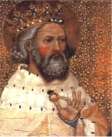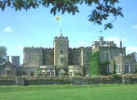Dawlish History
11th - 12th Century History
St. Edward the ConfessorIn 1044 St. Edward the confessor, the last Anglo-Saxon king, was on the throne of England. The parish of Dawlish, whose only estate was Holcombe, was part of the king's private possessions retained for his own use. However, Edward granted the parish to his chancellor and chaplain, Leofric, on the condition that he build bridges and supply soldiers to construct defences in time of war. The charter explaining this donation is in the archives of Exeter Cathedral and is well preserved. Much of it was written in Latin, although the boundaries of the land donated were given in English (Anglo-Saxon). This is the oldest record of Dawlish in history.  |
|
|
The bounded area equated to 4980 acres, but from the original charter it is difficult to pinpoint exact boundaries. From present day landmarks the land would have started at Teignmouth Point, followed a line along the beach to the quay and then a straight line to the bottom of Dawlish Street. After St Michael's Church the boundary followed Dawlish Hill, turned left at the top and proceeded along Oak Hill Cross Road to Oak Hill Cross and then to Holcombe Down. From Holcombe the boundary turned right along the present road, past the golf course and Ashcombe Tower, down Jubilee Hill, up the hill at Houndspool to Five Lanes and on to Gulliford. The boundary then continued in a straight line to a point on the River Exe between Cockwood and Starcross. The boundary then followed the bank of the Exe to Shutterton Marsh, followed a straight line in the direction of Warren Road and to the coppice on Marina Estate where the Warren Road begins. Here the boundary turned left to the beach joining at a point near Rockstone Bridge. The next mentioned landmark was Red Stone which may have been Red Rock at Boat Cove (at this time there were other large costal rocks in this region which have since disappeared).
The boundary then turned south out to sea for a short stretch and then turned west back to Teignmouth point. At this time Dawlish was spelt 'Doflisc' (Anglo-Saxon) or 'Dolfishe' (Latin). The exact meaning or derivation is unknown though is thought to have meant 'a fruitful mead in a bottom, or on a river's side'. Throughout the 1st century Dawlish was referred to by many names. Generally, before the 1st century Dawlish was synonymous with 'Devil Water' and after with 'Meadowland by Running Water', the latter being the motto adopted in the 20th century by the local council. |
|
Bishop Leofric
Three years after being granted the parish of Dawlish, Leofric became Bishop of Crediton and consequently in charge of the sees of Devon and Cornwall. Leofric was a devout, religious man whose main occupation was preaching the word of God. At the time war was inevitable, and it was the duty of the church as well as the throne to protect the people of the land. Leofric saw the suffering caused by the invasion of the Danes: Crediton had recovered well despite the lack of war defences; Exeter had not recovered so well. Realising the defence weaknesses of his dioceses and the lack of defences in Exeter, Leofric contacted Pope Leo IX who granted him approval, along with King Edward's consent, the move of his sees to the diocese of Exeter making him the first Bishop of Exeter with sees that included most of Dawlish, but not Holcombe. Leofric could now provide defences for regions under his control.  |
|
Feudal DawlishAfter Leofric's Death in 1072, Dawlish is mentioned in the Doomsday book again, outlining the land and property owned by the Bishop Osbern (Leofric's successor). It mentions that the bishop had 30 villeins (a villein being a person who is bound to the land and owned by the feudal lord), 8 bordars, 3 serfs, 3 cows, 2 swine, 100 sheep, a coppice 3 furlongs in length and 1 in breadth, 6 acres of meadowland and 12 acres of pasture. Its worth being 8 pounds a year, 1 pound more than in Leofric's time. It is clear from this Doomsday entry that Dawlish had cultivated land with sheep as its main wealth. The villeins would have lived in cob hovels that clustered around the church and worked the Bishop's land under the feudal system. They would have lived mainly off beans, fruit and hard bread with lard whenever they could get hold of some, and off meat from sheep that had died from disease, known as 'bracky mutton', even though this was a punishable crime at the time. Fish would have been part of the diet of some and storing fish in salt would have provided food during winter. Local cider and beer would have been produced, providing a safer source of liquid than the water at the time. There is nothing written about the feudal lord who managed the land and inhabitants, although according to tradition he lived on the land that is now Luscombe Estate. Evidence of an earlier building is found here. |
|
The CourtenaysThe Courtenay's (now lady and lord of Powderham) connection to the area began during the 11th century. For a period between the 11th and 12th centuries several minor lords from Okehampton controlled Holcombe and East Teignmouth.
At the time the see of Okehampton was held by the Courtenays. For more information on the history of powderham castle visit here.. |
|
The FurnellsSometime during the reign of King Henry I (1100-1135), the Furnell family acquired hunting rights to land in Dawlish. The first evidence of this came from King Henry II (1154-1189) who prepared a charter to re-establish hunting rights to Phillip de Furnell on the warren of Dawlish in the same manner as had been given to the Furnells by his grandfather: Henry I. The warren mentioned was not Dawlish Warren, but rather an area that is now Kenton. The grant gave exclusive rights to Phillip making it illegal for anyone else to hunt in the region without his permission. In 1148 the canon of Exeter, Alfred, was assigned the churches of Dawlish (Duuelis) and Teignmouth (Teigemudha) by the Bishop Robert Chichester for his support. Pope Eugene III later confirmed this in 1152. In the Papal Bull (decree from the pope) the town is also spelt 'Douelis'. |
|
| continue... |













